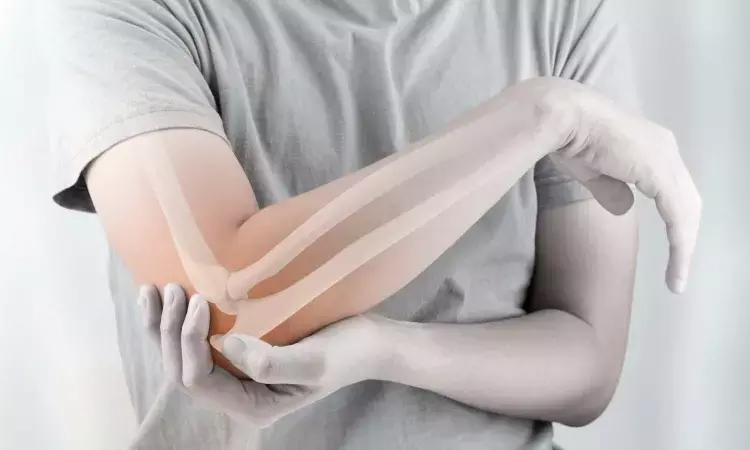- Home
- Medical news & Guidelines
- Anesthesiology
- Cardiology and CTVS
- Critical Care
- Dentistry
- Dermatology
- Diabetes and Endocrinology
- ENT
- Gastroenterology
- Medicine
- Nephrology
- Neurology
- Obstretics-Gynaecology
- Oncology
- Ophthalmology
- Orthopaedics
- Pediatrics-Neonatology
- Psychiatry
- Pulmonology
- Radiology
- Surgery
- Urology
- Laboratory Medicine
- Diet
- Nursing
- Paramedical
- Physiotherapy
- Health news
- Fact Check
- Bone Health Fact Check
- Brain Health Fact Check
- Cancer Related Fact Check
- Child Care Fact Check
- Dental and oral health fact check
- Diabetes and metabolic health fact check
- Diet and Nutrition Fact Check
- Eye and ENT Care Fact Check
- Fitness fact check
- Gut health fact check
- Heart health fact check
- Kidney health fact check
- Medical education fact check
- Men's health fact check
- Respiratory fact check
- Skin and hair care fact check
- Vaccine and Immunization fact check
- Women's health fact check
- AYUSH
- State News
- Andaman and Nicobar Islands
- Andhra Pradesh
- Arunachal Pradesh
- Assam
- Bihar
- Chandigarh
- Chattisgarh
- Dadra and Nagar Haveli
- Daman and Diu
- Delhi
- Goa
- Gujarat
- Haryana
- Himachal Pradesh
- Jammu & Kashmir
- Jharkhand
- Karnataka
- Kerala
- Ladakh
- Lakshadweep
- Madhya Pradesh
- Maharashtra
- Manipur
- Meghalaya
- Mizoram
- Nagaland
- Odisha
- Puducherry
- Punjab
- Rajasthan
- Sikkim
- Tamil Nadu
- Telangana
- Tripura
- Uttar Pradesh
- Uttrakhand
- West Bengal
- Medical Education
- Industry
Study identifies association of haemoglobin levels with BMD and fracture risk in patients with type 2 diabetes

China: A recent study published in Frontiers in Endocrinology has identified an association between haemoglobin (Hb) levels and bone mineral density (BMD) and 10-year fracture risk among a population with type 2 diabetes (T2D).
The study provided a new perspective on the association of Hb level and BMDs with fracture risk.
The study further revealed that relatively high haemoglobin levels protected bone quality in an older male population with type 2 diabetes, but lower Hb levels were associated with lower BMD and high future fracture risk in a non-older female population with T2D.
"The bone-protective effect of haemoglobin is influenced by sex and age and persists only in older men and non-older women with T2DM," the researchers wrote.
Osteoporosis is a disease characterized by weaker, more fragile bones, and lowered bone density—patients with diabetes experience an increased osteoporosis risk, particularly in the Asian population. Anaemia incidence is also higher in T2D patients compared with the general population. Previous research has identified an association between anaemia and osteoporosis in people with T2D, irrespective of sex and without stratification by age.
Against the above background, Ren-xuan Li, Shandong University, Jinan, Shandong, China, and colleagues aimed to investigate the associations between haemoglobin Levels and BMD and fracture risk in type 2 diabetes populations of different ages.
For this purpose, they conducted a cross-sectional study comprising 641 patients with T2DM (57.9% males). BMD of the femoral neck (FN), lumbar spine (LS), and total hip (TH) were measured using dual-energy X-ray absorptiometry.
The 10-year probability of fracture was evaluated using a fracture risk assessment tool (FRAX). Haemoglobin and other biochemical indices were measured in a certified laboratory at a hospital. Generalized additive models (GAMs) were used to identify the associations between Hb and BMD and fracture risk.
The study led to the following findings:
- Patients with osteoporosis have lower haemoglobin levels than the non-osteoporotic population and lower FN BMD in patients with anaemia than in the non-anaemic population.
- In patients with T2DM, there was sex- and age-related variability in the correlation between HGB levels and BMDs and fracture risk.
- In older men, haemoglobin level was an independent determinant of BMD and was positively correlated with FN and TH BMD.
- In non-older women, haemoglobin level was an independent determinant of BMD and fracture risk, positively associated with BMDs, and negatively associated with the 10-year probability of fracture risk.
- GAMs revealed a positive linear association between haemoglobin level and BMDs in non-older female patients but not in older male patients.
"The present study showed for the first time that lower haemoglobin levels are associated with lower FN and TH BMD in older male T2D population and that lower Hb levels are associated with lower BMD and higher future fracture risk in a non-older female T2D population," the researchers wrote. "Relatively low HGB levels in this population may be an independent risk factor for osteoporosis and osteoporotic fractures."
"There is a need for further studies to confirm these results and investigate the potential mechanisms," they concluded.
Reference:
Li R-x, Xu N, Guo Y-n, Wang Y, Liang Y-w, Zhou X-l, Jiang W-t, Wei J-x, Zhang X-y, Zhou L-n, Zhu L, Zhou Y-m and Xu J (2024) Hemoglobin is associated with BMDs and risk of the 10-year probability of fractures in patients with type 2 diabetes mellitus. Front. Endocrinol. 15:1305713. doi: 10.3389/fendo.2024.1305713
Dr Kamal Kant Kohli-MBBS, DTCD- a chest specialist with more than 30 years of practice and a flair for writing clinical articles, Dr Kamal Kant Kohli joined Medical Dialogues as a Chief Editor of Medical News. Besides writing articles, as an editor, he proofreads and verifies all the medical content published on Medical Dialogues including those coming from journals, studies,medical conferences,guidelines etc. Email: drkohli@medicaldialogues.in. Contact no. 011-43720751


